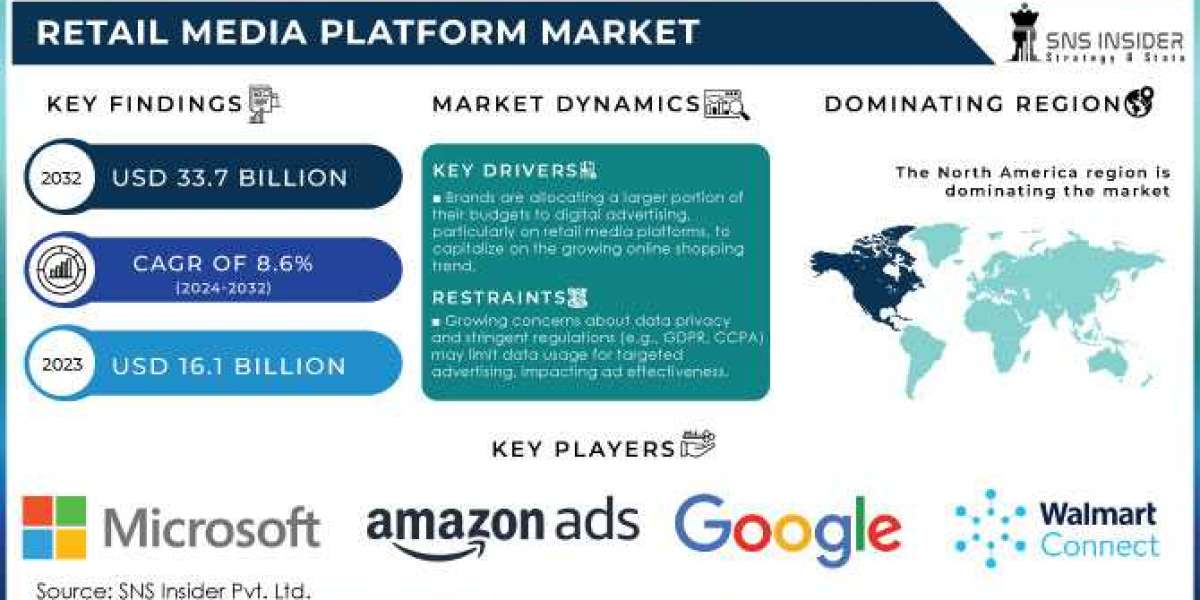The Retail Media Platform Market research study includes a full review of the elements affecting the worldwide market scenario. The study report provides the most up-to-date market information on future trends, as well as product and service breakdowns. The research includes critical facts on the market's current state, size, share, and growth factors. It also includes information about the emerging player's competitive status, sales, revenue, and global market.
Download Sample Copy of this Report: https://www.snsinsider.com/sample-request/4559
Retail Media Platform Market Key Players:
- Amazon Advertising (Amazon DSP, Sponsored Products)
- Google (Google Ads, Shopping Ads)
- Criteo (Criteo Retail Media, Criteo Dynamic Retargeting)
- Walmart Connect (Walmart Media Group, Sponsored Products)
- Target (Roundel, Sponsored Ads)
- Rakuten Advertising (Rakuten Marketing, Rakuten Insight)
- Meta (Facebook) (Facebook Ads, Instagram Shopping Ads)
- Kroger Precision Marketing (Kroger Media, KPM Insights)
- Microsoft (Microsoft Advertising, Bing Shopping Campaigns)
- Verizon Media (Oath, Verizon Media DSP)
- Adobe (Adobe Advertising Cloud, Adobe Experience Manager)
- Mediavine (Mediavine Ads, Mediavine Publisher Network)
- ChannelAdvisor (ChannelAdvisor Retail, ChannelAdvisor Advertising)
- Taboola (Taboola Commerce, Taboola Feed)
- Sizmek by Amazon (Sizmek Ad Suite, Sizmek Insights)
- PubMatic (PubMatic Retail, PubMatic OpenWrap)
- Magnite (Magnite Retail, Magnite OpenMarketplace)
- Skimlinks (Skimlinks Monetization, Skimlinks Analytics)
- Impact (Impact Partnership Cloud, Impact Attribution)
- Zalando (Zalando Media Solutions, Zalando Advertising)
- others
The Retail Media Platform market is experiencing rapid expansion as retailers increasingly recognize the value of leveraging their digital properties to monetize customer interactions through targeted advertising and personalized content. These platforms allow retailers to integrate advertising solutions directly into their e-commerce websites, mobile apps, and in-store experiences, creating new revenue streams while enhancing the customer shopping journey.
Market Segmentation
By Advertising Format
- Display Ads
- Search Ads
- Sponsored Content
- Others
By Deployment
- Cloud
- On-Premises
By Platform Type
- Retailer-Owned Media Networks
- Third-Party Media Networks
- Integrated Media Platforms
By Industry Vertical
- Consumer Packaged Goods (CPG)
- Electronics and Technology
- Apparel and Fashion
- Grocery and Food Delivery
- Beauty and Personal Care
- Others
Browse Complete Report: https://www.snsinsider.com/reports/retail-media-platform-market-4559
All major sources were canvassed for qualitative and quantitative data to be gathered and authenticated, as well as future perspectives. In this work, both qualitative and quantitative factors were examined for gathering and validating primary materials during the long primary research process.
It also covers the Retail Media Platform Market size and growth of various segments, as well as growth trends, as well as key stakeholders such as investors, CEOs, traders, suppliers, global managers, managers, presidents, SWOT analyses (strengths, weaknesses, and organizational threats), and others. Revenue projections, market share, competitive landscape, growth, and trends are all factors to consider.
This research displays the revenue, price, market share, and growth rates of each product category in terms of revenue, price, and market share. This research examines the current state and future prospects of key applications/end users, as well as consumption (sales), market share, and growth rates for each application, with a focus on key users/applications.
Regional Overview
A comprehensive market analysis takes into account a wide range of factors, from demographics and business cycles in a certain country to microeconomic effects on the Retail Media Platform Market. According to the findings, market paradigms have shifted in terms of regional competitive advantage and, as a result, the competitive landscape of significant firms. Analysis of downstream demand, as well as raw material and equipment management.
Competitive Outlook
The study includes a company market share analysis to provide a more comprehensive picture of the major industry players. The study also covers important market strategic developments such as acquisitions and mergers, new technology launches, agreements, partnerships, collaborations and joint ventures, research and development, and geographical growth of major market participants on a worldwide and regional basis.
Key Points Presented in the Market Report
- The global Retail Media Platform Market's introduction, market driving forces, and overall scope.
- Identifying and evaluating the most important actors in the competitive landscape.
- Presenting market dynamics, including market drivers, restraints, trends, challenges, and opportunities.
Report Conclusion
The study can assist in gaining in-depth market understanding and strategizing for business expansion accordingly. It offers insight into potential growth plans to improve market positioning, as well as a complete examination of potential new entrants and existing competitors in the Retail Media Platform Market.














